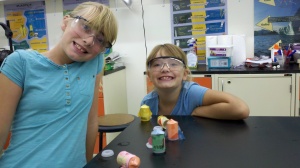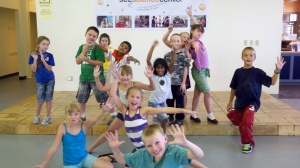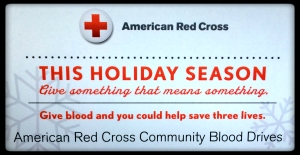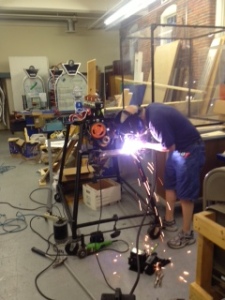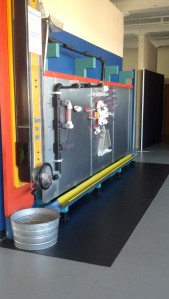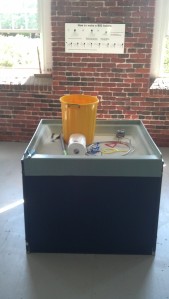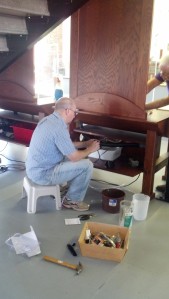Home » Posts tagged 'Science'
Tag Archives: Science
What happens before an exhibit arrives on the exhibit floor at SEE?
By Adele Maurier Design Coordinator
A lot of different scenarios can play out before an exhibit arrives at SEE for you to enjoy. Some of our exhibits are built on site in the SEE workshop, other exhibits are purchased from other science centers and others are custom built for us by exhibit design firms. But the most special exhibits to us are the exhibits that were built with the local community. Going back to the very beginning of SEE in 1986, working with community partners has not only been essential to our success, but something that brings us great pride and satisfaction – and we meet a lot of great people! Through the years many different community partners have worked with SEE to create and build exhibits. The biggest example is our LEGO Millyard Project, where four local organizations and over 200 volunteers helped plan and build the exhibit from 2004 to 2006. Recently SEE had the privilege to work with Community Partners to build the Hybrid House.
The Hybrid House is one component of the “Green Revolution”, an exhibition originally created by the Museum of Science and Industry, Chicago, and made available by the Smithsonian Institution Traveling Exhibition Service (SITES). The typical recipe for traveling a museum exhibition is to pack objects into crates, load them onto trucks, and then have those trucks travel the highways to museums across the country. “Green Revolution,” however, is an innovative museum exhibit where participating venues receive all of the necessary design files and instructions digitally, allowing them to construct and customize their very own home grown “eco-zibit” from re-used, recycled materials found within their local community.
The Hybrid House was funded in part by a grant from PSNH and the NH Center for Non-Profits. Exhibit construction was completed by a broad partnership including PSNH employee volunteers, the Manchester Community College, and the UNH Cooperative Extension. A significant portion of the materials for the project were donated by Coastal Forest Products and Bedford Fields. The result is a house built with sustainable construction that contains exhibits on six home energy efficiency topics. The volunteers gave their time and skills and creativity to bring a one-of-a-kind exhibit to the SEE community. Visit SEE any day to check it out!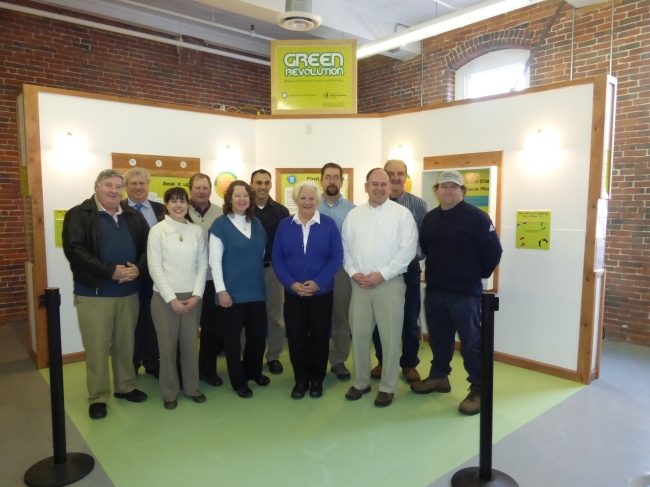
Caption:
Celebrating the Hybrid House Opening are volunteers from PSNH(front, l-r): Jack Schelling, Adele Maurier (SEE Science Center Design Coordinator), Thelma Brown, Nancy Rheinhardt, Mark Toussaint, and Dave Simard. In the back are Douglas Heuser (SEE Science Center Executive Director), Randy Dixon, Mike Loughlin, Dave Still, and Ray Horion. Missing from photo are Jim Zattlerand John Beaney, who were responsible for much of the construction, Margaret Hagen and Pam Doherty from the UNH Cooperative Extension who were responsible for much of the signage and Dana Mosher from Manchester Community College and Stephen Floyd from PSNH who designed the wall construction.
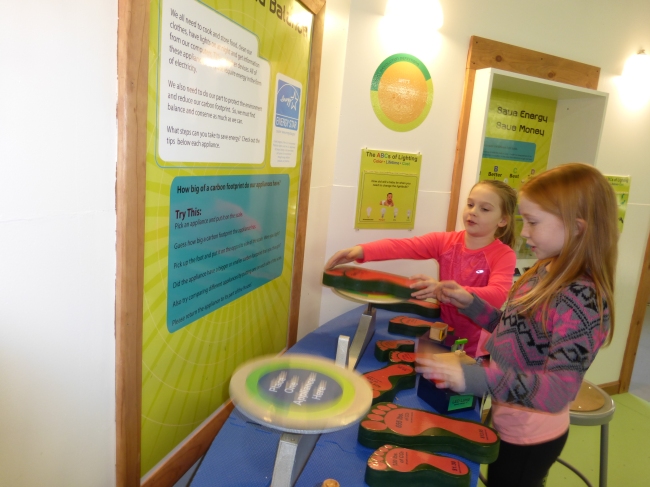
What materials were recycled to create the Hybrid House? Some examples: The balance at the center of the house was once part of an exhibit on aging; the introductory sign was once part of an exhibit on communications.
Camp Summer Science
Becky Mayhew
Operations & Programs Manager
becky@see-sciencecenter.org
Summer is coming faster than we realize and that means I am getting ready for summer camp here at the SEE Science Center! Although it ranks right up there as two of my most tiring weeks of the year, they are also a contenders for my two favorite weeks of the year. I honestly have just as much fun as the campers. Our science camp is all hands-on and extremely engaging.
For most of the year, I interact with a child for an hour or two during a school field trip but during camp we have a whole week filled with cool science activities.This year I am excited about two brand new modules we are offering to our campers. Nano Science, which is the science of things that are TINY! It should be really interesting exploring things that are too small to see. And the very tricky Science of Magic which will delve into some of the science behind the magic. Add in some serious free explore time at the science center, Reverse Engineering, exhibit prototype building and top it off with a Make Your Own Sundae Party and how can you lose?
I am SO ready! Now all I need are the campers…
SEE Celebrates
By Douglas Heuser
Executive Director
This past October, one of our young employees agreed to speak at the SEE Celebrates event held at the home of our founder, Dean Kamen. She is studying to be an archaeologist and spoke about how SEE inspired her love of science. She has been coming to SEE since she was a small child. We have shared some of her words and the words of others who took the time to speak on SEE’s behalf this year in our annual campaign.
When I first met with Dean 30 years ago and listened to his vision of how to inspire young people to get interested in science and math, I hoped that we could create the type of place that SEE has become, a place that generates interest in scientific pursuits that lead to STEM careers.
Has SEE influenced your life and/or career? Please share your story with us. Our goal is to ignite a spark of discovery in all our visitors: with your support we can continue to do so. Please take a moment to read our annual appeal, and consider a donation. SEE would not be where it is today without strong community support.
You can send your story to: douglas@see-sciencecenter.org
The Giving Season
By Peter Gustafson
The SEE Science Center has numerous partners in the Greater Manchester community and as we look to them for support of our programs and events, they look to us for support as well. We have given family memberships as gifts to help support the fundraising efforts of such groups as the Manchester Community Music School and the Majestic Theatre and SEE makes similar contributions to hundreds of PTAs and PTGs every year.
SEE offers coupons and passes to organizations to help them gain visibility and add value to their efforts. Groups like Child and Family Services, the Gail Singer Memorial Blood Drive and Southern New Hampshire University have used our passes and coupons as thank-yous for donors and in-coming students.
During the days of December 16, 19, 20 & 21 SEE will be partnering with the American Red Cross at the Manchester Blood Donation Center, giving any individual who donates blood a coupon for reduced admission to the SEE Science Center. There are other partners and incentives for each day of the Drive:
Monday 12/16: Raffle for a Massage Envy gift certificate
Thursday 12/19: Raffle for a Signature Facial and Swedish Massage Package courtesy of Exhale Spa. Back Room Chicken Tenders will be served.
Friday 12/20: Raffle for a car detailing package courtesy of Manchester Suzuki. Enjoy Subs from Subway.
Saturday 12/21: Raffles for a Dustin Pedroia autographed baseball and a CarWash book and oil change courtesy of Kerner’s Car Wash.
So help us help a local cause and please give blood this month!
Introducing Manchester’s first Science Café: Science on Tap
By: Chad Campbell, Client Development Associate
I love the concept of Science on Tap, Manchester’s new Science Café, for a few reasons; science, beer, and bar food.
I’m also a huge fan of how Manchester organizations are helping lead the charge with promoting science for everyone (from K-12 programs at The SEE Science Center, college level classes through STEAM Ahead NH and for the 21-and-older crowd at Science on Tap). Our city is a growing technology and business hub, and these types of programs show how proud we are of it, and attract people to our city’s culture and promise.
The premise of a Science Café is to bring together scientists and the community to discuss different topics of interest in an informal setting. Together with the SEE Science Center, UNH Manchester, and The Shaskeen Irish pub, we have created Manchester’s first Science Café.
First topic was off the hook
Our first event focused on the New England fishing industry, sustainable fishing and the labeling and regulations that our panel of scientists deal with every day. Our scientists; Jill Swasey from MRAG Americas, and Eric Chapman and Gabriela Bradt from New Hampshire Sea Grant all brought unique experience and expertise that gave the group of about 30 science and/or beer enthusiasts a good overview of this complex issue.
Here’s what I learned about the fishing industry
· It is way too complex for the average consumer to understand everything about where the fish they eat comes from.
· There are multiple agencies that certify a fishery as sustainable
· There are multiple government agencies that are involved in the fishing industry
· Everything varies upon region
· There isn’t a fish that you could definitively say, across the board is more sustainable than another
· Not everyone in the fishing industry follows the rules
But just because it’s confusing doesn’t mean we should stop trying.
As consumers, we have to educate ourselves about where our food comes from, how it’s caught and the impact that has on the fishery and ecosystem. Is it local? If so, is the species you are eating sustainable for your local waters? If it’s farmed, is it a species that is sustainable and doesn’t take up more resources than it gives back?
There are many guides and apps out there to help answer those questions. A few to check out include: Marine Stewardship Council, Seafood Watch, Blue Ocean Institute, NOAA FishWatch.
This infographic from Jill Swasey is a great place to start.
OWOO_KnowYourSeafood_banner
Our next topic is pretty sweet
Science on Tap happens every second Tuesday of the month. Next up is The Science of Chocolate at 5:30 p.m. on Tuesday, Dec. 10. Admission is free, and The Shaskeen will donate a percentage of food and beverage sales from the event to the SEE Science Center.
If you are a scientist, doctor or engineer and are involved with something that you think would be a good fit for Science on Tap, please reach out. Follow SEE Science Center on Facebook for cool science related information from around the globe once a day and more updates about Science on Tap.
New York City Marathon
Hello SEE Science Center Community,
The staff at SEE asked me to share my NYC marathon experience. I’m Craig and have been on the SEE Science Center Board of Directors for a decade. There is a lot of science surrounding marathon running, but rather than diving into that, I’ll focus on the events of the day.
My day started at 4:00am on Sunday morning in a hotel near Central Park. I had my usual oatmeal (carbs), banana (potassium) and tea (caffeine) and was out the door at 5:00am to catch a cab. There was a group of 5 of us that had completed a 20 week training program to prepare. Our cabby went to their hotel to pick them up and then off to Battery Park to catch a ferry to Staten Island. From there, we boarded buses to the staging area for the start. If you recall, Super Storm Sandy forced the marathon to be canceled last year. Because of that, and the events at the Boston Marathon this year – there was a record number of runners – 50,700 in all. The theme of Boston Strong was everywhere. From blue ribbons given to us by race organizers, to signs, to Boston gear (lots of Red Sox caps). We had time to relax and stretch before heading to our starting corral. The weather was ideal except for a 15-20mph head wind that we would experience for most of the run.
I was able to run for a bit with one of my training partners and in the first mile we noticed our first unusual runner – a man dribbling two basketballs – yes – he was attempting to run 26.2 miles while bouncing two basketballs – yikes.
The NYC marathon is known for its cheering crowds and our day was no different: literally millions of spectators cheering us on at every stage of the race. Running the bridges was cold because we were exposed to the wind. One thing I noticed is the truly international flavor of the race. I’ve run the Boston marathon many times and there are always lots of foreigners in that race, but nothing like NYC. During my run, I talked to runners from France, Italy, Mexico, and New Zealand. It seemed like every country on the planet was represented. Even at the finish line, the race provides assistants and each of them was wearing tags indicating the languages they spoke. Need to speak in Cantonese – no problem. Another thing that was different from my other marathons (this was my 13th) was the level of security. After the horrible day at the Boston marathon this year, the folks in NYC were determined to prevent anything similar. At times it felt like we were in a war zone. Armed police everywhere, helicopters flying low (at a couple points the helicopters were so low, you could feel the whoosh of their blades).
As for my race – I had a good day. I had prepared well so I was hoping to run a good time. I was able to keep a very steady pace of 7:31 minutes per mile. My plan was to start easy, run within myself and hope that in the later stages I could turn it up a bit. At various points (mile 8, 16, 19) I was feeling strong and considered picking up the pace. But I stuck to my plan and stayed consistent. I’m glad I did because at Mile 22 I needed to call upon my reserves to carry on. You may have heard of ‘hitting the wall’ or ‘bonking’ – that’s what hit me in the last few miles. If marathons were only 22 miles long – more people would run them. The race begins at Mile 22. I slowed to an 8:00 minute per mile pace for the last few miles, but managed to run a ‘clean’ 26.2 miles (no stopping, walking, etc).
My time was 3 hours, 21 minutes and 37 seconds. It was a personal best for me by two minutes. I finished 2983 overall, which put me in the 91st percentile. I finished 2671 in my gender, which put me in the 96th percentile. And I finished 50th in my age bracket (55-59) out of 1858, which put me in the 97th percentile. All results I’m very pleased with. And keep in mind, about 80 percent of the runners are younger than me, so finishing in the 90th percentiles means I passed a lot people younger than me.
What’s next – Boston 2015 (2014 is already sold out). In order to get into Boston you need to run another marathon with a designated qualifying time based on your age (or fundraise your way in). For my age bracket (55-59) I need a qualifying time of 3:40 or faster. My time of 3:21 puts me well under that and allows me early acceptance.
Today I can finally walk up and down stairs without hobbling (lactic acid build up makes your muscles very sore for several days after the race). Our group plans to run a few miles on Saturday. Many of them will be running Boston this year, so they will take a few weeks off and then begin training again. This winter I plan to do some snowshoeing with my dogs and run a few days a week to keep in shape.
If you or anyone you know wants to try and run a marathon – let me know. We have a large group of runners in the Manchester area – male and female, all ages and abilities. Our policy is to leave no man behind. On a typical Saturday morning long run (15+ miles) we have 15-20 people running. We have spirited conversation and all have the same goal of running a ‘clean’ marathon.
One final story – my own personal comedic moment of the day. Once you have finished they give you a bag filled with water, Gatorade and various salty snacks. I was craving salt (if you look at a runner after they have finished a marathon, their face is covered with salt from the sweat evaporating off their face) – so I opened a bag pretzels. I don’t recall exactly what I did next, but I think I turned my wrist so I could look at my watch. When I went to get a pretzel the bag was empty. Yes – I had dumped the pretzels out of my bag. I was like a little kid who had his Halloween bag of candy taken – very sad. I looked at the person who was walking right behind me and they were laughing and confirmed what I had done. All I could do was laugh. By the way – that runner offered me their pretzels. Before, during and after – all marathon runners are comrades.
Enjoy your day and get out there and run. 🙂
Craig Ahlquist
Chair, SEE Science Center Board of Directors
Why Science on Tap?
The SEE Science Center and science centers in general want to encourage engaging, lifelong informal science learning. Science Cafés, with their casual atmosphere in the community and open dialog format, fit naturally with this goal. (And we love to head out to a bar and discuss science as much as anybody.) So SEE decided to try out the concept several years ago while hosting a traveling exhibit called “Seasons of Change”. We did a series of three events. They were a success! From that time forward we looked for the opportunity to host an ongoing series of events. With the help of two wonderful volunteers, Chad Campbell from SilverTech and Ginger Lever from UNH Manchester, we are able to launch Science on Tap next week. A key piece of the puzzle was to find the right room for the events. The series will be held in the back room at the Shaskeen on Elm Street. Their support made Science on Tap a reality. So join us Nov. 5th at 5:30pm for our first discussion “What’s on the Menu? Understanding the Labels Behind Sustainable Seafood.” Learn more about the Science on Tap and check in here using Eventbrite. And if you are interested in joining the committee or have a great topic or speaker to suggest, just send us an email.
Guest Blog by SEE volunteer Richard Maurier
There’s a lot of behind the scenes work needed to keep exhibit breakdowns at bay. When I see the great joy children get out of a fun learning experience it motivates me to help keep the exhibits up and running. Whenever I tackle a breakdown I always look to find the cause as well as the correct repair solution. Next I look to see if I can prevent the same problem from happening by tweaking some weak point. Next I test the whole exhibit to see if new problems are creeping up and finally I test the exhibit (I enjoy that a lot) to make sure it will keep running well.
Recently I’ve been working on the cutaway 6 cylinder gas engine exhibit. It’s been down for a while but with the extra time I take to get it just right I’m hoping it will run better and longer than ever. Lots of men I know who’ve brought their children to SEE say it’s one of their favorite exhibits.
I’ve also helped the staff to bring new exhibits on line. I feel good when a new idea gets developed and finally the young visitors get their hands on it and try it out.
There are a lot of exhibits out back that I’d like to bring out and watch the children try out. I wish I could spend more time getting them ready. If you think you could offer some help please talk to the staff. I’m sure they would love to have more
volunteer exhibit repair/refurbishing help. I can tell you it’s personally very rewarding work.
SEE Science Center Annual September Cleaning
SEE is closed….what? That’s disappointing I know. But why is SEE closed every year around the same time? Well it’s time to clean things up, fix anything that may be broken or sometimes even add something new.
With thousands of families and hundreds of school groups visiting SEE every year things can get a little dirty. So from September 3rd through September 13th the staff here is working very hard to spruce things up.
We are winding down week 1 of our annual shutdown now and I must say things are looking great. We here at SEE greatly appreciate your patience and understanding and we look forward to seeing you on September 14th when we will reopen all shiny and clean.
We are looking forward to another year of hands-on fun and learning together!
Camp Summer Science Week One comes to an end…
By Becky Mayhew Education & Program Manager
Another busy, hands-on, exhausting, science filled camp week has come to an end. Last week was filled with great activities – dismantling a variety of electronic items, exploring flight and air pressure, creating toys that demonstrated scientific principles – and even more great memories. One camper came to me at the end of every activity block to give me a high five to show me his appreciation. One camper’s creative mind came up with an exhibit prototype that combined history and science creating a science time traveling device. Another camper came to me each day insisting on showing me a new exhibit he discovered in the science center during free explore time (even though I have worked here over twenty years). Our campers were engaged, inventive, sometimes a little loud and crazy, but always fun. I will miss this batch of campers and our week together. Luckily, Camp Summer Science Week 2 starts today!

